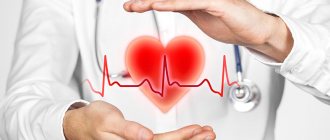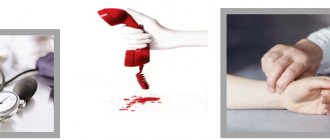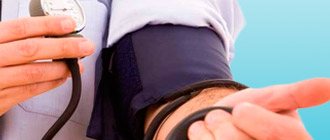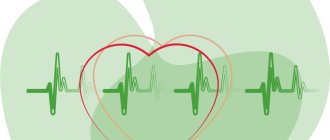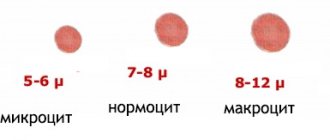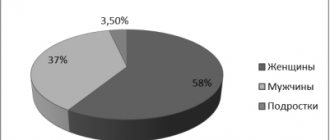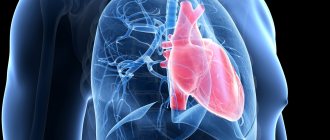Treatment of stage 2 hypertension, symptoms and causes
Stage 2 hypertension is arterial hypertension in moderate form. The upper blood pressure (systolic) is 160 - 179 mm Hg, and the lower blood pressure (diastolic) is 100 - 109 mm Hg. At this stage of the disease, periods of increased pressure are longer than with stage 1 hypertension. Arterial blood pressure in grade 2 hypertension rarely returns to normal.
Depending on the rate of change in the degree of hypertension, we can talk about normal and malignant arterial hypertension. In the second case, the disease progresses so quickly that it is often fatal. Hypertension is dangerous because an increase in the speed of blood movement through the vessels leads to thickening of their walls and an even greater narrowing of the arteries.
Risks of developing hypertension
The risk of developing hypertension or arterial hypertension - high blood pressure - consists of a number of factors. Accordingly, the more there are, the greater the likelihood that a person will become hypertensive.
Risk factors for developing hypertension:
- stress (stress hypertension) and mental stress. The stress hormone adrenaline increases your heart rate. It instantly constricts blood vessels;
- taking certain medications, for example, oral contraceptives, and various dietary supplements (iatrogenic hypertension);
- male gender;
- age over 35 years;
- pregnancy;
- diabetes;
- endocrinopathy of the adrenal glands, thyroid gland or pituitary gland;
- diseases of the hypothalamus;
- pyelonephritis;
- renal failure (nephrogenic hypertension);
- inactivity. Physical inactivity is accompanied by a slow metabolism - metabolism - and gradually weakens the body as a whole;
- excess salt in food. Table salt provokes arterial spasm and retains fluid in the body;
- excess body weight. Each extra kilogram increases blood pressure by 2 millimeters of mercury - mmHg;
- sudden change in weather;
- hereditary predisposition. The risk of getting sick is higher for those who have hypertension among first-degree relatives: father, mother, grandmothers, grandfathers, siblings. The more close relatives suffer from high blood pressure, the greater the risk;
- bad habits: smoking or drinking alcohol. Components of tobacco provoke spasms of blood vessels - involuntary contractions of their walls. This narrows the blood flow;
- atherosclerosis – blockage of blood vessels with plaques. Total cholesterol should not exceed 6.5 mmol/l of blood;
- chronic lack of sleep and other “provocateurs”.
Depending on the combination and degree of manifestation of the above factors, as well as the likelihood of cardiovascular complications in the next decade, there are 4 types of risk of developing arterial hypertension:
- low (risk less than 15%);
- average (from 15 to 20%);
- high (more than 20%);
- very high (more than 30%).
Risk factors for the appearance of arterial hypertension are also divided into 2 types based on the possibility of their elimination: correctable (correctable) and not. For example, a person may well quit smoking, but he is not able to change his ancestry. The amount of risk is summed up from a number of indicators. A patient with stage 1 hypertension who begins to abuse alcohol will significantly increase the percentage chance of developing complications.
Additional recommendations
The risk of relapse of the disease remains high even after recovery. This risk can be minimized by adhering to certain restrictions. The list is small and will be useful not only for hypertensive patients, but also for people who care about their health.
The bathhouse is a taboo for hypertensive patients. A sharp change in temperature can lead to hypertensive crisis and other consequences
Necessary:
- Quit smoking and alcohol, which negatively affect the condition of blood vessels.
- Introduce regular physical activity into your daily routine, as agreed with your doctor.
- Limit salt intake to a minimum.
- Eliminate stressful situations. If this is not possible, it is necessary to take sedatives that calm the nervous system.
- Minimize the amount of salt in your diet. Exceeding the permissible doses of this product leads to fluid retention in the body, which leads to changes in blood pressure and deterioration of the heart and circulatory system.
- Lose weight. Considering that every excess kilogram adds 2 mmHg. to the numbers on the tonometer. This means that losing weight in this case is not a tribute to the fashion for slimness, but taking care of your own health.
- Be sure to take the hypertensive medications prescribed by your doctor. It is important to do this not only during an exacerbation, but also during remission of the disease.
- When creating a menu, you should pay attention to healthy low-calorie foods rich in vitamins, fiber and microelements. The most beneficial for hypertensive patients are: vegetables, fruits, dried fruits, cereals, low-fat dairy and fermented milk products, lean meats and fish. You should avoid fatty meats, butter and margarine, smoked foods, and preserves.
Hypertension is a disease that does not disappear on its own. Only an integrated approach can achieve lasting results and improve the patient’s condition, bringing it closer to normal levels.
The danger of high blood pressure
The main danger of hypertension is its complications, leading to disability and death.
The most severe complications:
- from the heart - heart attack, development of arrhythmia, heart failure;
- in the brain - stroke, loss of memory and intellectual abilities (dementia);
- from the eyes - severe vascular disorders in the retina;
- kidney – the occurrence of failure;
- vessels - aneurysm (sac-like expansion) of the aorta, the rupture of which leads to almost instant death.
Causes of hypertension
True hypertension, or, as it is also called, essential hypertension, occurs as a result of overstrain of the nervous system. The result of this process is a disruption of the processes of regulation and maintenance of optimal blood pressure.
Scientists have identified many factors that contribute to the occurrence of hypertension:
- excessive emotional stress;
- irregular working hours;
- lack of sleep;
- obesity;
- physical inactivity;
- diabetes;
- alcohol and tobacco abuse.
The hereditary dependence of the formation of hypertension has been proven - more than 20 genes have been identified that are responsible for the development of the pathology.
What is stage 2 hypertension
Stage 2 hypertension is a condition characterized by a persistent increase in blood pressure to 160/100 and above. However, blood pressure rarely returns to normal on its own; drug treatment is required to correct the patient’s condition.
Stage 2 hypertension is more common in patients over 50 years of age and this is understandable. With age, changes occur associated with the deposition of cholesterol plaques and narrowing of the lumen of blood vessels, the load on the heart increases, which has to make more efforts to pump blood, and conditions arise for increased blood pressure.
Treatment methods
To stabilize blood pressure, the following groups of drugs are prescribed:
- calcium channel blockers;
- α and β-blockers;
- ACE inhibitors;
- diuretics;
- sedatives;
- medications that have a blood-thinning effect;
- vitamin and mineral complexes that strengthen the immune system.
In advanced cases, surgical intervention is performed. Indications for surgery for stage 3 hypertension:
- acute vascular stenosis;
- advanced atherosclerosis;
- renal pathologies;
- heart disease;
- aortic aneurysm.
Symptoms of stage 2 hypertension
Stage 2 hypertension has ambiguous symptoms and treatment. Increased blood pressure may be accompanied by the following symptoms:
- Throbbing pain in the temporal region;
- Swelling of the face, especially the eyelids;
- The facial skin is hyperemic, and spider veins appear over time;
- Hands swell;
- It gets dark in the eyes, “spots” periodically flicker;
- At the same time, there is aching pain in the back of the head;
- After waking up, there is no cheerfulness, fatigue and apathy persist throughout the day;
- Periodic noise in the head;
- Emotional lability – low threshold of excitability;
- Dilated blood vessels of the eyes (sclera);
- Compaction of the ventricular wall (resistance to blood flow is compensated);
- Involuntary urination due to renal failure;
- Heart rate increases with the slightest exertion;
- There are problems with remembering.
Hypertension of the 2nd degree, symptoms can change depending on its characteristics: a primary independent form or a secondary one, as a complication of another disease.
Characteristic symptoms
Symptoms develop in isolation only in the case of the primary origin of the pathology. If hypertension is a complication of other diseases, the symptoms develop nonspecific.
General symptoms of stage 3 arterial hypertension:
- A sharp, unbearable headache localized in the occipital, temporal and parietal areas.
- Disorientation in space. An increase in blood pressure leads to dysfunction of the vestibular apparatus, as a result of which it is difficult for the patient to navigate in space.
- Ringing, noise in the ears.
- Weakness, drowsiness or, conversely, hyperactivity. In the latter case, the patient is very overexcited, it is difficult for him to relax and fall asleep even if he is very tired and feels unwell.
- Memory loss, slow thinking. The patient cannot always follow the meaning of the conversation and often forgets recent events.
- Arrhythmia. It manifests itself as a rapid or, conversely, pathologically rare heartbeat.
In the chronic course of hypertension, the symptoms are blurred. The pain in the head almost disappears and makes itself felt only periodically. Other suspicious symptoms may be completely absent.
Risk 2 for stage 2 arterial hypertension
When establishing the risk of a characteristic illness, doctors take into account the age, gender, and presence of chronic diseases in the body of a clinical patient. This information helps predict clinical outcome and reduce the likelihood of serious health complications and disability. Risk 2 for arterial hypertension of the 2nd degree means that irreversible processes in internal organs under the influence of surges in blood pressure are observed only after 10 years, the probability of stroke and heart attack is 20%.
How is the disease diagnosed?
To diagnose arterial hypertension, a doctor needs to take several blood pressure measurements at different times of the day. If necessary, a specialist can prescribe ABPM - an instrumental study in which blood pressure is monitored throughout the day using a special device.
Differential diagnosis of hypertension occurs as follows:
- An examination of organs whose pathologies could cause increased blood pressure is performed. For example, the examination may include an ECG, ultrasound of the kidneys, and fundus examination.
- If secondary hypertension is excluded and a specific cause for the increase in blood pressure is not found, then a diagnosis of hypertension is made.
Arterial hypertension 2 degrees risk 4
Risks of arterial hypertension 2 degrees The presence of a “bouquet” of diseases (atherosclerosis, diabetes, ischemia) allows us to state that the patient has acquired a diagnosis of hypertension 2 degrees, 4 risk. Arterial hypertension at this stage only complicates the situation. This diagnosis is given to patients who have survived 1-2 heart attacks, regardless of the affected area.
It should be clarified that one hundred risk is a predictable concept, not an absolute one. It only indicates the likelihood of a complication developing. If the patient understands the danger of his situation and takes appropriate measures, the diagnosis can be corrected. Hypertensive patients who adhere to a healthy lifestyle and constantly monitor their condition can live a long and fulfilling life.
While with a burdened anamnesis and high risk, life expectancy is significantly shorter. Timely diagnosis and adequate treatment aimed at reducing blood pressure can extend your life and improve your quality of life.
general information
Most often, it is not possible to establish the causative factor that led to a long-term increase in the level of pressure in the bloodstream. In this case, a diagnosis of essential or primary hypertension, also called hypertension, is made.
The danger of the disease lies in the fact that over time a person simply gets used to high marks on the tonometer, feeling at the same time satisfactory. With high blood pressure, not only the vascular system is affected, but also the heart, brain, and kidneys. The latent course of the pathology can lead to serious consequences: heart attack, stroke, kidney and heart failure, coronary artery disease.
Treatment of stage 2 hypertension
How to treat stage 2 hypertension? The scheme is drawn up by the local therapist. If necessary, a consultation with a cardiologist and neurologist is scheduled. Traditional methods of treating stage 2 hypertension include:
- To eliminate blood thickness (thin the blood flow), you should take Aspirin, Cardiomagnyl, Heparin, Aspicard.
- To normalize blood pressure, diuretics (diuretics) are prescribed, such as Diuver, Furosemide, Piretanide, Torasemide, Veroshpiron, Ravel.
- For this diagnosis, thiazides (thiazide drugs) such as Arifon, Chlorthalidone, Indapamide are recommended.
- To reduce blood cholesterol, you should take lipid-lowering drugs such as Atorvastatin, Atoris, Liprimar, Zovasticor.
- In order to dilate blood vessels, antihypertensive drugs of different groups are prescribed, such as Physiotens, Artil, Bisoprolol, Lisinopril.
It is important to consider that the quality of treatment largely depends on compliance with the instructions for their use. Self-medication for hypertension is dangerous. Such experiments can result in disability. The therapist selects the treatment regimen individually, taking into account the age, build and other health characteristics of the individual patient.
Forecast
Arterial hypertension is a progressive pathology. Over time, it leads to the development of severe complications that can cause the death of the patient. Among the most common lethal complications are myocardial necrosis, decompensated heart and vascular failure, hemorrhagic stroke, and impaired renal excretory function.
A persistent increase in blood pressure greatly increases the risk of cardiovascular complications. The mortality rate among patients with this disease in the second stage compared to the rest of the population is on average four times higher. First of all, this applies to patients who do not control their blood pressure. People who regularly take antihypertensive medications and follow their doctor's recommendations have a much lower risk of such complications, resulting in a significantly lower mortality rate.
These severe consequences of the disease can only be avoided by paying close attention to your health, visiting a doctor on time and following his recommendations regarding treatment and lifestyle changes.
Diet for hypertension
In order for the kidney vessels to function normally, hypertensive patients with any stage of the disease must adhere to certain nutritional rules. For example, it is important to control the water and salt balance of the body, to prevent the formation of stagnation and, as a consequence, stage 2 hypertensive crisis. Fatty, fried, sweet and smoked foods are prohibited.
Seven foods that lower blood pressure:
- Blueberries – Blueberries are rich in natural substances called flavonoids.
- Fresh leafy greens such as fenugreek leaves, kale, mint leaves, patchouli, dill greens, mustard leaves, curry leaves, beet greens, Swiss chard, arugula, broccoli, celery and spinach are high in potassium
- Potatoes - contain a lot of potassium and magnesium
- Beets – Nitrates in beet juice are known to lower blood pressure
- Skim milk is an excellent source of calcium plus low fat levels
- Oatmeal is a high-fiber, low-fat, low-sodium food.
- Bananas – Adds potassium to your diet.
Therapeutic nutrition for stage 2 hypertension allows boiled lean meats, cereals, vegetables and fruits on the menu. Green tea and diuretic herbal decoctions have beneficial properties.
Folk remedies
When treating illness at home, many people prefer to use folk remedies. This therapy involves the use of medicinal plants that have a positive effect on the cardiovascular system.
You can treat the disease with the following recipes:
- Treatment can also be carried out with peppermint, cinquefoil, chamomile, and yarrow. These herbs go well together.
- Prepare a decoction of motherwort, horsetail, marsh cudweed, and valerian root. All plants must be taken in the same quantity. This remedy has diuretic effects and allows you to cope with single surges in blood pressure.
- Bee products and citrus fruits are actively used in the treatment of hypertension.
- You can treat with viburnum juice. To reduce blood pressure, it should be consumed three times a day, a quarter glass.
Folk remedies help cope with unpleasant symptoms of the disease and speed up the effectiveness of traditional therapy. Such recipes have proven their benefits over many centuries. People whose bodies do not tolerate medications well turn to this type of therapy. But it is important to remember that treatment of the disease with traditional recipes can only be carried out after consultation with a doctor.
Features of the course of hypertension with heart damage
A prolonged or particularly malignant course of the disease affects the heart muscle. Initially, myocardial hypertrophy develops - with the help of this, the heart tries to compensate for the excess load. Without treatment or if it is insufficiently effective, as well as with irregular medication use, the following types of heart damage may develop:
- angina pectoris - acute pain in the heart caused by a lack of oxygen;
- heart attack - an extreme degree of coronary artery disease, manifested by necrosis of the heart muscle;
- acute left ventricular failure - manifested by cardiac edema.
Prevention
Your healthcare provider will likely also suggest a variety of lifestyle changes, including:
- Maintaining a healthy weight;
- A diet rich in fruits, vegetables and low-fat dairy products;
- To give up smoking;
- Limiting salt intake in the diet;
- Limit alcohol consumption. For most adults, this means that it is normal to drink up to one drink per day for women of all ages and men over the age of 65, and up to two drinks per day for men 65 or younger;
- Exercise at least 30 minutes a day. These include walking, jogging, strength training, yoga, and cardio exercises such as cycling.
On your part, methodical adherence to medical recommendations and organization of the correct regimen are required. A healthy lifestyle is the path to recovery. Remember this.
Gradation of risk of complications
Depending on the presence of certain factors, four degrees of risk of hypertension are distinguished, according to which the likelihood of developing fatal complications of the disease in the next ten years
.
Table. Gradation of risks
| Other risk factors, asymptomatic end organ damage or associated diseases | High normal pressure | AH 1st degree | AH 2 degrees | AH 3 degrees |
| No other risk factors | Low risk | Medium risk | High risk | |
| 1-2 risk factors | Low risk | Medium risk | Medium and high risk | High risk |
| 3 or more risk factors | Low to medium risk | Medium and high risk | High risk | High risk |
| Target organ damage, stage 3 CKD. or diabetes | Medium and high risk | High risk | High risk | High and very high risk |
| Cardiovascular disease, CKD 4 or higher, diabetes with end-organ damage/risk factors | Very high risk | Very high risk | Very high risk | Very high risk |
A low risk of fatal complications is established when the patient does not have the factors listed above. When there are no more than two risk factors, the probability is set as average. Risk 3 is determined in patients with three harmful factors, and risk 4 is established in the presence of four or more.
Based on the information listed above, we can say that second-degree hypertension with a risk of 2 will mean that the patient has an increase in blood pressure in the range from 160 to 176 mm Hg, and there are one or two risk factors for severe complications.
